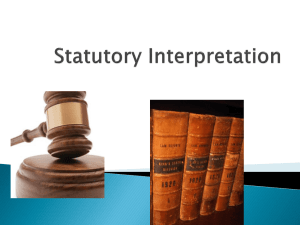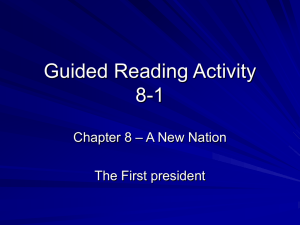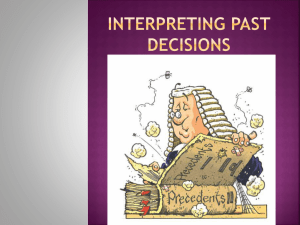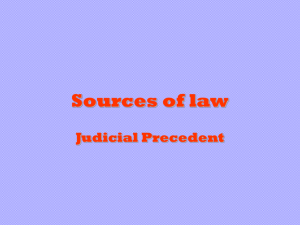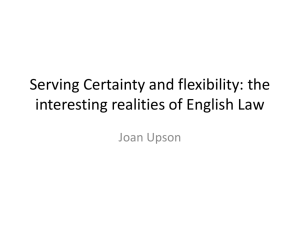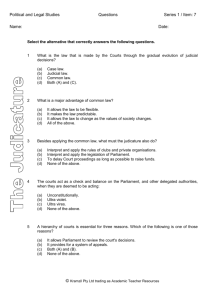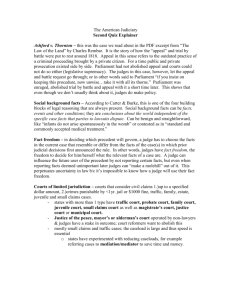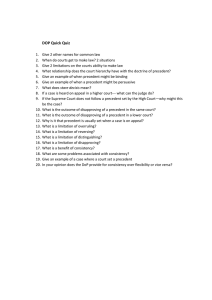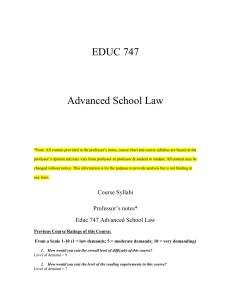Unit 3 Outcome 3 Past exam questions and suggested answers
advertisement
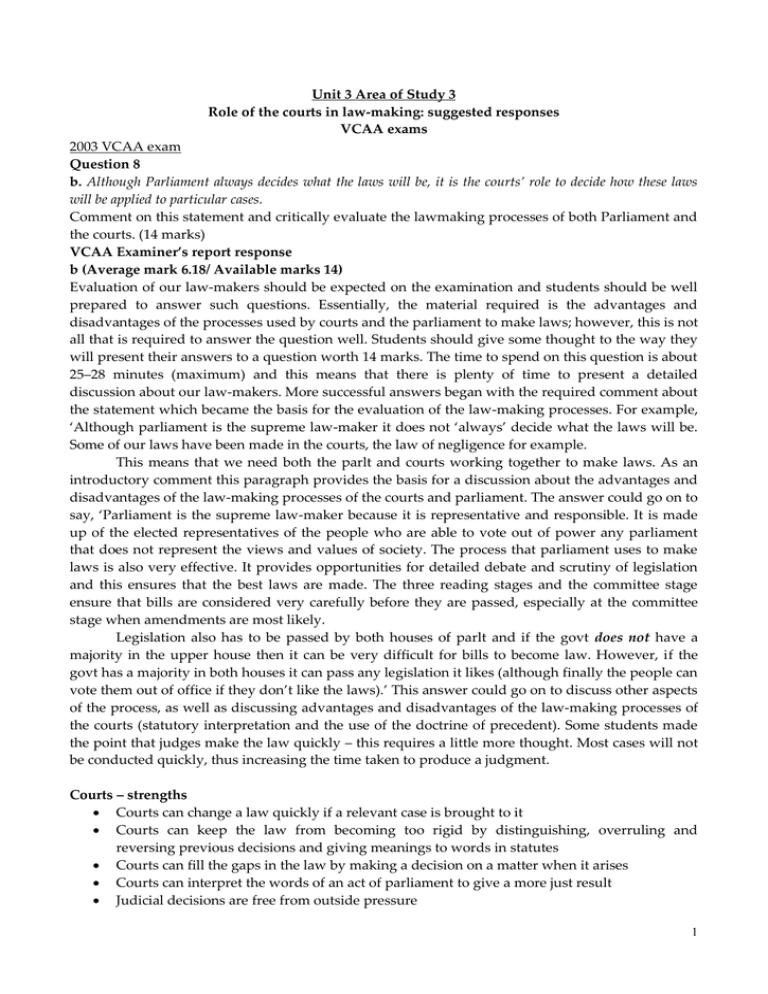
Unit 3 Area of Study 3 Role of the courts in law-making: suggested responses VCAA exams 2003 VCAA exam Question 8 b. Although Parliament always decides what the laws will be, it is the courts’ role to decide how these laws will be applied to particular cases. Comment on this statement and critically evaluate the lawmaking processes of both Parliament and the courts. (14 marks) VCAA Examiner’s report response b (Average mark 6.18/ Available marks 14) Evaluation of our law-makers should be expected on the examination and students should be well prepared to answer such questions. Essentially, the material required is the advantages and disadvantages of the processes used by courts and the parliament to make laws; however, this is not all that is required to answer the question well. Students should give some thought to the way they will present their answers to a question worth 14 marks. The time to spend on this question is about 25–28 minutes (maximum) and this means that there is plenty of time to present a detailed discussion about our law-makers. More successful answers began with the required comment about the statement which became the basis for the evaluation of the law-making processes. For example, ‘Although parliament is the supreme law-maker it does not ‘always’ decide what the laws will be. Some of our laws have been made in the courts, the law of negligence for example. This means that we need both the parlt and courts working together to make laws. As an introductory comment this paragraph provides the basis for a discussion about the advantages and disadvantages of the law-making processes of the courts and parliament. The answer could go on to say, ‘Parliament is the supreme law-maker because it is representative and responsible. It is made up of the elected representatives of the people who are able to vote out of power any parliament that does not represent the views and values of society. The process that parliament uses to make laws is also very effective. It provides opportunities for detailed debate and scrutiny of legislation and this ensures that the best laws are made. The three reading stages and the committee stage ensure that bills are considered very carefully before they are passed, especially at the committee stage when amendments are most likely. Legislation also has to be passed by both houses of parlt and if the govt does not have a majority in the upper house then it can be very difficult for bills to become law. However, if the govt has a majority in both houses it can pass any legislation it likes (although finally the people can vote them out of office if they don’t like the laws).’ This answer could go on to discuss other aspects of the process, as well as discussing advantages and disadvantages of the law-making processes of the courts (statutory interpretation and the use of the doctrine of precedent). Some students made the point that judges make the law quickly – this requires a little more thought. Most cases will not be conducted quickly, thus increasing the time taken to produce a judgment. Courts – strengths Courts can change a law quickly if a relevant case is brought to it Courts can keep the law from becoming too rigid by distinguishing, overruling and reversing previous decisions and giving meanings to words in statutes Courts can fill the gaps in the law by making a decision on a matter when it arises Courts can interpret the words of an act of parliament to give a more just result Judicial decisions are free from outside pressure 1 The doctrine of precedent limits possibility of prejudices influencing judicial decisions Appeals process allows for the review of decisions. Courts – weaknesses Courts cannot change a law unless a case is brought before the court Courts may be bound by an old precedent, which could lead to unjust results Changes in the law through the courts are ex poste facto Changes through the courts is very expensive for the parties involved Parliament can override court-made law some judges are very conservative and could be reluctant to change bad laws Not a democratic system of law-making and judges tend to be drawn from a narrow, socioeconomic background and are usually male though this is increasingly being addressed. 2004 VCAA exam Question 1 Provide two reasons why judges need to interpret statutes. (2 marks) Suggested response The words contained in legislation may be ambiguous, requiring the court to interpret the words and apply them to the case. One of the key roles here for the court is to determine parliament’s intention in the original drafting of the legislation. Where inconsistencies arise between Acts, or between 2 or more sections of the same Act. In this situation, the courts must determine which of the sections of legislation should prevail. 2004 VCAA exam Question 8 b. Describe how courts and Parliament make law. Discuss two differences between the lawmaking processes of courts and Parliament. 10 marks A very good answer presented the material in the following way: Courts make law essentially as a byproduct of dispute resolution. They make common or case law through the doctrine of precedent and statutory interpretation. The doctrine of precedent is based on the concept of .stare decisis. (to stand by the decision) and refers to the notion that the reasoning (or ratio decidendi) behind decisions of higher courts should be binding on lower courts in the same hierarchy where the facts of the case are so similar that they cannot be distinguished. Statutory interpretation is where a judge gives meaning to the words in the laws passed by Parliament. This meaning may form a precedent for future, relevant cases. Parliament is the supreme lawmaker and is able to make laws by following the legislative process of debate and questioning in order to create statutes or legislation. Bills are introduced into either house of Parliament (with the exception of money bills that must originate in the lower house) by the Minister responsible for the area of law or an individual member of Parliament. The bill undergoes a first and second reading, detailed scrutiny in the committee stage, and a third reading in both houses of Parliament. The Royal Assent is given by the Queen’s representative if this process is passed successfully. The final stage is the proclamation of the law. One difference between the lawmaking processes of courts and Parliament is the ability of Parliament to make law at any time, as long as they are sitting. They have the capacity to make laws very quickly whenever the need arises, as long as the issue isn.t so controversial that they decide to defer the decision to legislate (eg, abortion). In contrast, courts may perceive the need to create a law, but can only make laws when a case is brought before a superior court. They are not as free as Parliament to make laws, and may even be bound by precedent that will prevent a court from making law even if there is a need to. 2 Another difference is the resources available to both lawmakers. Parliament has an array of experts and technical advice at its disposal when assessing the need for change and drafting a bill. They can even initiate government inquiries and VLRC recommendations to assess the alternatives and variety of opinions on an issue. In contrast, courts are reliant on and limited by the information presented to them by the parties to a dispute and so the resources available are much less than those available to the Parliament. Other differences that could have been mentioned include: Parlt can make law in futuro, while changes in the law through the courts are ex poste facto Parlt can delegate legislative power to subordinate authorities in areas where this is most effective; courts do not have this authority Members of Parlt are democratically elected; judges are appointed and independent the Parliamentary process can be compromised by pressure from special interest groups; the courts are free from any obligation to listen to the community’s views on a matter relating to cases before them. 2005 exam – Question 9 ‘A weakness in Australia’s system of law-making is that both parliament and courts can make law. It would be better if law-making was left to parliament alone.’ Discuss this statement indicating the extent to which you agree or disagree with it. Justify your conclusions. (12 marks) Breaking down the question Students need to acknowledge that there is a quote attached to the question. This quote needs to be referenced in the answer to show the assessor that the question has been read carefully. This is not simply a strengths and weaknesses of parliaments and the courts question. It refers to the law-making process, so this would need to be explained in the first part of the response: The law-making process of parlt (initiation, the passage of a bill, royal assent and proclamation) The process of law making by the courts: explaining that the doctrine of precedent is based on the common law, which is developed through court decisions. Brief reference would be made to binding and persuasive precedent. The key aspect of the statement ‘both parliament and courts can make law’ should be addressed next. Answers should mention that courts make law through statutory interpretation (giving meaning to the words in Acts of Parliament) and comment on the complementary role of the courts and parliament as law makers: - Statutory interpretation can set a precedent that will be binding or persuasive on judges. - A wide interpretation extends the law to cover a new situation or new area of law. - A narrow interpretation may restrict the law to cover only certain situations. - Statutory interpretation does not amend or modify the actual words in the Act. - The interpretation or definition of a word is only valid for the statute interpreted. Discussion of the parliament as a law-maker: examples of strengths and weaknesses Strengths Parliament investigates areas for reform and collects information from a variety of sources to make informed decisions when drafting Bills. Through the VLRC, committees and public inquiries, parliament allows the community to be actively involved in regard to proposals for law reform. The public is given the opportunity to submit written and oral statements in an attempt to influence law reform, which provides for representative govt. 3 Parliament makes law in futuro and has the power to cover future circumstances. This creates confidence in the legal system in that the community can be informed of changes and then plan accordingly. Parliament undertakes public education programs before the law comes into effect, especially in key areas such as taxation and road laws. Weaknesses Politicians are conscious of public opinion and therefore, controversial areas such as euthanasia may not be addressed because political parties fear losing voter support. Where the government does not control the upper house, such as at the Commonwealth level, the opposition can frustrate its legislative program purely for political purposes. Changing statute law can be very time consuming, and much needed law reform can be delayed because opponents of the government wish to indulge in ‘point scoring’ rather than an objective analysis of the issues. On the other hand, if the government controls the upper house, such as in Victoria, it might act only as a ‘rubber stamp’ and not vigorously review government Bills. Discussion of doctrine of precedent: examples of strengths and weaknesses Strengths Courts can keep the law from becoming too rigid by distinguishing, overruling and reversing previous decisions and giving meanings to words in statutes. In this way, courts can fill the gaps in the law by making a decision on a matter when it arises. Judicial decisions are free from outside pressure. The doctrine of precedent limits the possibility of prejudices or bias influencing judicial decisions. Weaknesses Courts cannot change a law unless a case is brought before the court. In this way, judges may be bound by an old precedent, which could lead to unjust results. Change through the courts can be very expensive for the parties involved. Overall conclusion Students should now address the part of the question, ‘indicating the extent to which you agree or disagree with it’. It would be wise for students to argue that the parliament and courts work together as law-makers and it could not be said that law-making should be left only to parliament. The courts play a vital role in hearing and determining disputes and in the process, creating legal principles that affect the scope of legislation. The courts also play the vital role in declaring legislation ultra vires that is not constitutional according to powers given to the law-making body. 2010 VCAA exam Question 9 The doctrine of precedent allows for both consistency and flexibility. Critically examine these two strengths of the doctrine of precedent. (6 marks) The doctrine of precedent allows for consistency The doctrine of precedent limits the possibility of prejudices influencing judicial decisions. The doctrine of precedent allows some level of consistency in decision making; similar cases with similar circumstances need to follow precedents in higher cases, thereby ensuring appropriate legal advice can be given in some areas of law. Courts may be bound by an old precedent, which could lead to unjust results. 4 Courts have ways to move around precedents (distinguishing, in particular), which may result in inconsistency. The doctrine of precedent allows for flexibility The doctrine of precedent allows for some flexibility. The law can be expressed as a general principle (for example, the ‘neighbour test’) allowing the courts to adapt it to fit the circumstances before the court. Judges have some flexibility in avoiding precedent by: - distinguishing – a judge can avoid following a precedent if the case can be distinguished on the facts - overruling and reversing previous decisions – the High Court can overrule its own decisions - disapproving of a decision (for example, a decision from another jurisdiction) – a court can indicate that a precedent should no longer be regarded as good law. These methods of avoiding precedent are limited by nature – disapproving does not change a bad precedent, and overruling and reversing are only available to higher courts such as the Supreme and High Courts. Judicial decisions are not elected and are therefore free from outside pressure, allowing them to make more objective assessments of the need for a change in the law. This may be considered as allowing them to be flexible by not making decisions based on their own political needs. Courts cannot determine what the law is until a case is brought before the court. If there has not been a decision on a particular point of law from a higher court, there is uncertainty surrounding that area of law. Judges can be conservative in their approach, resulting in fewer changes to the law. Flexibility could lend to an inconsistent approach to cases should judges choose to distinguish or overrule previous decisions, thus jeopardising the strength of consistency. Given that the two strengths are so intertwined – in that, by judges being flexible they may be criticised for being inconsistent – students could have either tackled the two strengths together or separately. Stronger students planned their response, used clear paragraphs and made points about both consistency and flexibility, drawing out at least one weakness in both strengths (a requirement for an evaluation question). Many students had difficulty structuring their response and gave a general description of the operation of precedent and a limited examination of how it provides for consistency and flexibility. Many students incorrectly suggested that precedent is about the verdict or punishment given in criminal cases. Some students attempted to use cases such as Donoghue v Stevenson to explain how precedent works; however, students who did so struggled to give a critical examination of consistency and flexibility as strengths of the doctrine of precedent. Similar to critical evaluation, a critical examination requires a discussion of the strengths and weaknesses of both consistency and flexibility. Weaker students did not provide much detail on the methods of avoiding a precedent (distinguishing, overruling, reversing and disapproving) and simply listed them without any attempt to explain them or examine how they are a strength or weakness for either consistency or flexibility. 5 The following is an example of a high-scoring response. The doctrine of precedent refers to the process by which lower courts in the same hierarchy follow decisions of higher courts in similar cases with similar circumstances. This process provides for consistency and fairness by ensuring that similar cases are dealt with in a similar way by precedents set by higher courts being followed by lower courts. This level of consistency also allows for some predictability which enables legal practitioners to advise clients on possible outcomes of their case. The problem with consistency, however, is that if poor or bad precedents are set, then lower courts must follow them, thus causing injustice in cases as the precedents must be followed. Additionally, if courts are to change that precedent, then a higher court must wait for a case to come before them with similar circumstances in order for the precedent to be changed. The courts, by avoiding this consistency in precedents, also have some flexibility in avoiding precedents which including reversing, overruling, distinguishing and disapproving. However, there are some limitations in these methods of flexibility. Disapproving of a precedent is normally used by a judge in a lower court and does not change the precedent; it just highlights their disapproval of it. Reversing is only available when the case in which a precedent was set or followed is at appeal and the higher court decides to overrule the decision. Overruling is only available to courts higher than the court that set the precedent, and even then judges are often conservative and may not decide to overrule a precedent. Furthermore, distinguishing can only be available where the facts are different enough for this method to be justified. Finally, although these methods are available to the courts, they can cause the doctrine of precedent to be inconsistent and unpredictable, therefore need to be used in the appropriate case. 2011 VCAA exam Question 8b (Average score: 2.4/5) To what extent are judges bound to follow the new precedent in future cases with similar fact situations? Justify your answer (5 marks) According to VCAA assessors, this was a poorly handled question because many students simply produced a rote-learned answer. For this response, students needed to: Explain the operation of the doctrine of precedent with reference to the court hierarchy Outline the processes of reversing, overruling, disapproving and distinguishing. 2012 VCAA exam Question 3a (Average score: 0.7/2) ‘The Victorian court hierarchy is an important part of our legal system. It allows the doctrine of precedent to operate and it establishes the jurisdiction of courts.’ Explain one reason why a precedent established in the Victorian Supreme Court (Court of Appeal) may not have to be followed in the Victorian Supreme Court (Trial Division). This question was not handled well. Many students incorrectly assumed that the Court of Appeal was on the same level as, or lower than, the Supreme Court (Trial Division). The concept of the Victorian court hierarchy and where each court sits on that hierarchy forms the foundation for understanding other aspects of the legal system, such as the operation of the doctrine of precedent, therefore it was surprising to see many students provide incorrect responses to this question. As the Supreme Court (Trial Division) sits below the Supreme Court (Court of Appeal), the response that ‘the precedent is only persuasive’ (which was the most common incorrect response) was not accepted. Some students tried to argue that the Trial Division could disapprove the precedent and therefore not have to follow it. This demonstrates an incorrect understanding of how 6 the disapproving method works. Disapproving a precedent does not change it; it merely demonstrates a negative view of the precedent, but the judge is still bound to follow it. The following were acceptable responses. Distinguishing method: the Trial Division may find that some of the material facts in the case before it are distinguishable from the facts in the precedent case. The Trial Division may therefore determine that it is not a similar facts case and is therefore not bound by the precedent. Not a similar fact situation: the Trial Division may not have a case that is a similar fact situation. It may be a case that has a different focus or is on a different area of law and is therefore not bound by the rules of precedent. Abrogation: the Victorian Parliament may have subsequently abrogated the precedent established in the Court of Appeal after it was handed down and will therefore no longer be ‘good law’. (The statement in the question provided no temporal context as to when the precedent was created, so this was a sufficient response.) The precedent has already been reversed: the High Court may have subsequently reversed the precedent established in the Court of Appeal and is therefore no longer ‘good law’. (The statement in the question provided no temporal context, so this was a sufficient response). The following is an example of a good answer. One reason why the Trial Division of the Supreme Court may not have to follow a precedent established in the Court of Appeal is through the distinguishing method. The justice presiding over the case in the Trial Division may find that some of the facts in the case are materially different from those in the precedent and therefore it is not a similar facts case and therefore is not bound by the precedent. Question 10 (Average score: 2.5/6) The following comment appeared in a local Victorian newspaper. Why are judges able to change laws that are already in place? They should not be able to change laws. – Concerned Con from Kyabram Discuss the ability of courts to change the law. The focus of this question was the role of the courts in law-making, and more particularly the ability of courts in that law-making role to change the law. The stimulus material focused on the idea that judges are able to change the laws, which is true in many circumstances; however, students were expected to identify the limitations of this ability. Many student responses were unfocused, devoting much of the response to a discussion about a case (such as the ‘studded belt case’) rather than addressing the question. If students use cases as examples, they must be relevant and they must be applied to the question. Other students provided only a brief discussion about ‘RODD’ (reversing, overruling, distinguishing and disapproving) without any discussion about whether those methods actually change the law. More focus is required on the doctrine of precedent and statutory interpretation, and the role of courts generally, as the responses to this question were limited in scope and demonstrated a lack of understanding of the nature of courts. Some of the points that could have been made are listed below. The more successful students touched on a number of these points. 7 Where courts can change law Courts are able to interpret statutes when the need arises, and are able to change the meaning of words or phrases not otherwise intended by parliament. Courts can change law through statutory interpretation; courts may also expand or narrow the law and thus change the focus of the law. Courts are able to establish precedent in areas where there is no statute or no common law, such as developing laws relating to negligence against manufacturers. Courts are able to expand on precedent and develop common law in certain areas. The higher courts, particularly the Supreme and High Courts, are able to avoid following precedent as it is not binding on them and thus can create a new precedent. The higher courts can also overrule precedents on appeal. Courts are able to declare a law ultra vires or void if it is outside the law-making powers of the parliament that is making the law. Therefore, in those situations, the law is ultimately ‘changed’, with those parts of the law being struck out or declared invalid. Courts (as opposed to parliament) are free from political influences or from the threat of not being reappointed, and therefore are free to expand on areas of law or narrow/expand the meaning of a law. Where courts can’t change law Lower courts are bound by precedent and are unable to change the law, but may be able to note their disapproval. Courts have to wait until cases come before them: they are unable to change laws at their will like parliament can. Common law may eventually be abrogated by parliament, thus restricting the court’s control over common law remaining ‘good law’. The courts are limited to interpreting the law or creating common law based on the case that comes before them, although they can make comments in obiter dictum that may influence courts in future cases. Statutory interpretation is limited to interpretation of the words in the statute. While that may change the meaning of the words, the courts cannot change the words or amend statute. The following is the beginning of a high-scoring answer. The courts’ primary role is to resolve disputes, not to make or change laws. Therefore, the ability of the courts to change the law is ancillary to its role as a dispute resolver and therefore its ability is limited. The courts can change the law only when a case comes before them, and only if that case requires a ‘ change’ in the law. Many cases do not create precedent or do not involve the interpretation of statute, therefore the court’s role as a lawmaker is not invoked. In addition, given the courts have to wait for a case to come before them, it cannot just change a law as and when required, like parliament. The higher courts have a greater ability than the lower courts to change the law. The higher courts, such as the High Court or the Supreme Court, can overrule or reverse precedents, and the High Court is able to change the Constitution if required. However, the lower courts are bound by precedent and therefore have a limited ability to change the law. 8
